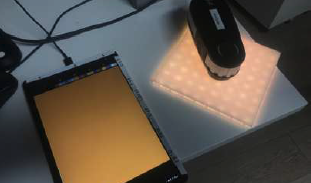
For a few years, the automotive industry has produced new cars with continuous changing display models, this by combining display sizes, forms, and technologies all together to bring new experiences to the users. In this paper we will present the color matching solution implemented for a new car display system where regular LCD display technology and LED lighting tiles are mixed together. The solution we proposed is based on accepted display model providing the transformation device RGB space to CIE XYZ independent color space and in reverse. The approach we followed choose the LCD display as reference, then transformation matrix is derived to modify the RGB LED control values. Once the color matching operation is applied, the color difference between the two display areas is greatly reduced.

The image qualities of LCD and OLED monitors set to their own default settings were compared using forced-choice experiment method. Both displays’ peak white luminance was around 1,000 cd/m2 and color gamut setting was fixed as DCI-P3 for LCD while OLED’s gamut was set as DCI-P3 or BT.2020. The twelve image quality evaluation keywords were collected through the focus group Interview and eleven HDR video clips were selected as test stimuli. During the experiment, the test video was shown on two displays placed side-by-side and thirteen naïve participants were asked to select the display having the better image quality. The experimental results showed that OLED has higher image quality than LCD does because of higher colorfulness in general. Black luminance level affected the image quality for the dark images but the images having large bright area, colorfulness affected the overall image quality. This result shows that not display technology but the color characteristics affects the image quality.

LCDs (Liquid Crystal Displays) have become the ubiquitous low-cost display technology, with full color displays offering good resolution costing less than $10. Although LCD modules generally include either a backlight or a reflective backing, the LC panel itself merely modulates light by altering polarization. Thus, it is possible to use a transmissive LC panel as a programmable optical filter, or LCLV (Liquid Crystal Light Valve). This paper explores a variety of potential uses of commodity LC panels, including color panels, to implement programmable apertures and filters for camera lenses.